Archive for the 'Cherries' Category
We have 3 cherry trees growing in our backyard. They are about 8 years old. The varieties are Bing, Rainier, and Royal Rainier. In previous years, I have found maggots inside some of the cherries. Last year, most of the cherries were infested with maggots, especially on the Royal Rainier. I noticed small flies buzzing around the fruit. I suspected that the flies were spotted wing drosophila (SWD). Most of the cherries were brown and inedible looking from the insect damage. I ended up throwing all of them away.
I was on the verge of removing all of our cherry trees, because I didn’t want to implement a spraying regime. I had the same problem with raspberries in the past. I sprayed the raspberries back then, but it didn’t help. I ended up removing all of my raspberries. But I wasn’t ready to give up on the cherries just yet. It has taken several years for them to reach the size they are and to start producing fruit. Also, removing the cherry trees now would require much more work than removing raspberries.
So this year I tried something different. I have netted the cherry trees with bird netting in past years to keep birds away, but the holes in bird netting are too large to keep out insects. The only type of netting I am aware of that has a mesh fine enough to keep out small flies is mosquito netting. So earlier this year, I bought some mosquito netting.
After our cherry trees were out of bloom in mid-April, I wrapped mosquito netting around our Royal Rainier cherry tree and tied it with twine around the trunk. I then rolled any open parts of the netting together and sealed the openings with clothes pins to keep insects from flying or crawling in. It helped that I have pruned this tree to keep it under 8 feet tall. I didn’t bother to net the other two cherry trees, because they set very few cherries this year. Here is what our tree looks like netted.
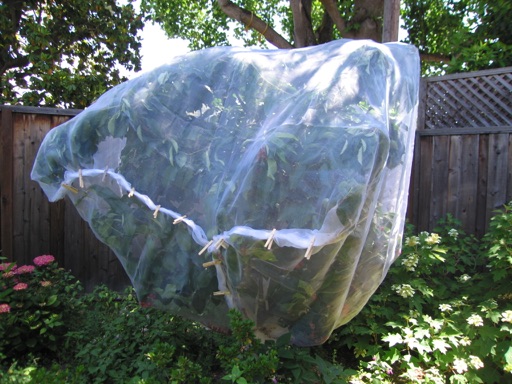
Last weekend, I harvested most of the Royal Rainier cherry crop. Here’s what they looked like inside the tree.
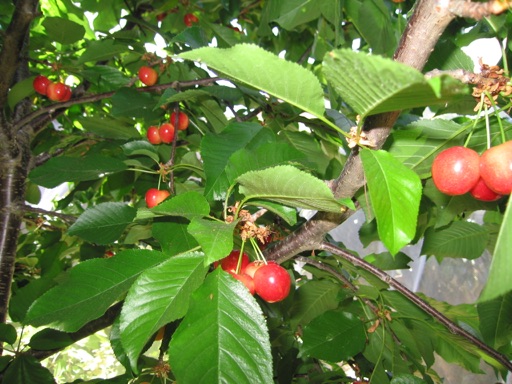
And here is what they looked like after harvest.
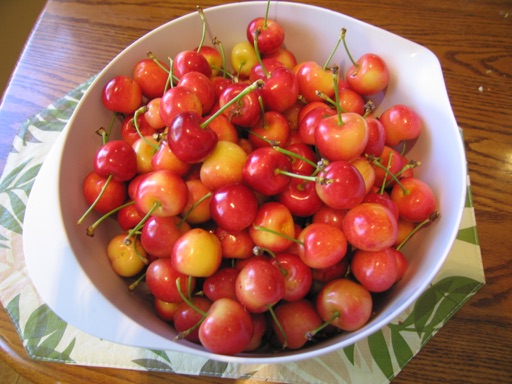
They look beautiful and taste amazing. Not one of the cherries appears to have been touched by birds or insects. We have eaten most of them already, and we haven’t found maggots in any of them. The netting also allowed me to leave the cherries on the tree long enough to fully ripen.
Netting a tree is extra work, and it is probably not practical for large trees over 10-12 feet tall. However, I think it was worth the effort. Mosquito netting is easier to work with than bird netting, because it doesn’t get caught on things as easily. And it keeps out all kinds of pests including insects, birds, and squirrels.
In fact, I am so happy with the results of the mosquito netting that I am using it to cover some of my other fruits and vegetables. For example, I am using it to cover broccoli and cauliflower to keep out cabbage moths and aphids. I am also using it to cover my blueberry bushes as shown below. Even though the netting has a fine mesh, it appears to be letting in enough sunlight for these plants to remain healthy and grow.
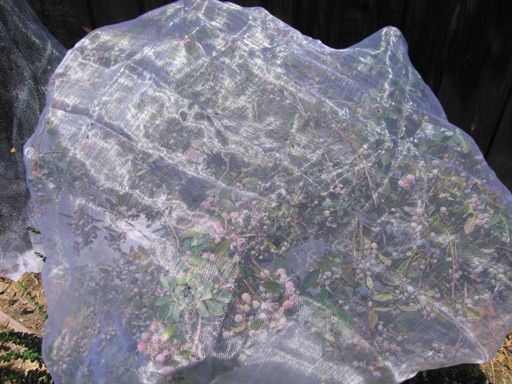
June 08 2017 | Blueberries and Cherries | Comments Off on Mosquito Netting
Our strawberry harvest started the second week of April, which is very early for our area. But, their growth and fruit production started to slow down around mid-May. At that point, I realized that our strawberry plants weren’t getting enough water from my automatic sprayers. For the past few weeks, I’ve been watering them by hand nearly everyday, and they seem to be responding to the extra water.
Our strawberry plants are now growing again and getting new flowers. In the past, I’ve thought that fertilizing regularly was the key to getting lots of strawberries for many months. But now I’m realizing, they just need lots of water, preferably a daily soaking.
Below is a picture of some of our Chandler strawberries growing in a pot. Chandler is one of my favorite varieties, because it produces large strawberries on strong stems. I have also been growing Sequoia strawberries for years.
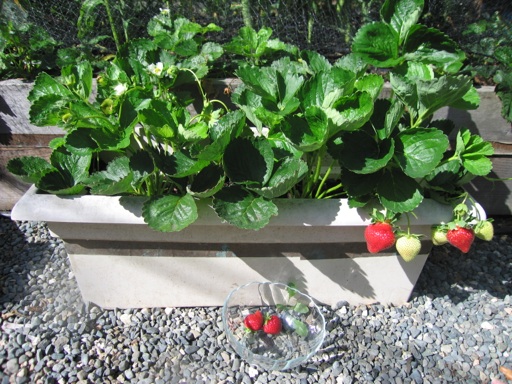
Last week, I planted some everbearing Albion strawberries, which I hope will produce berries in mid and late summer after the June bearing varieties are finished. This is a variety that I haven’t grown before.
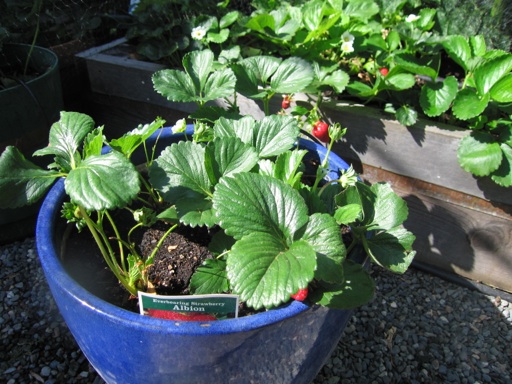
I’ve also been harvesting cherries from our Rainier and Royal Rainier cherry trees this past week. The Royal Rainer cherries are very sweet and mild (picture below). Our Royal Rainier tree has produced cherries nearly every year we’ve had it, which is about 5 years now. It has consistently produced more fruit than our other two cherry trees, even though it is smaller than our other cherry trees.
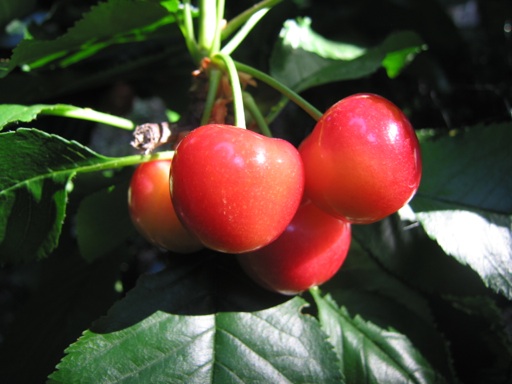
Our Rainer cherries are more tart, even though the tree is a year older than the Royal Rainer and visually the cherries look very ripe. Also, the tree doesn’t have many cherries, and this is the first year it has had more than 2 cherries. However, our Rainier tree is a very vigorous grower. It has grown to about eight feet tall and as wide despite regular pruning as shown below.
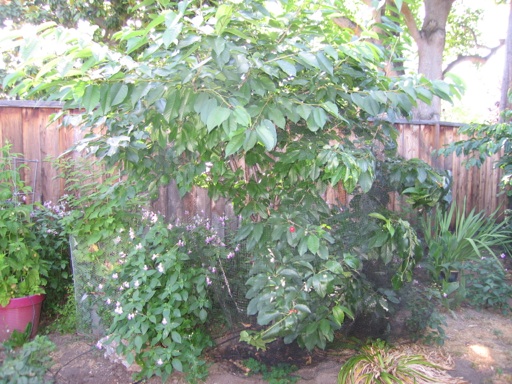
Our third cherry tree is a Bing, which also has its first significant crop of cherries this year. Its fruit is just starting to get a deep red color. I’m leaving the fruit on the tree, until they get nearly black. And of course, I have bird netting on all three trees. So far, it has prevented even a single cherry from being pecked at, as far as I can tell.
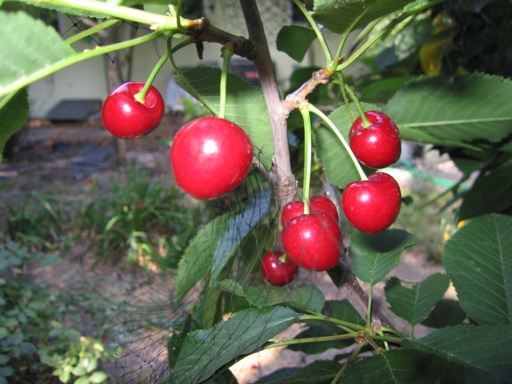
Our blueberry harvest also started the second week of April, which is about a month earlier than usual. I was picking blueberries from our Misty plant in April and early May. Moving it to a sunnier location and the warm weather we had this spring seem to be the reasons for the early harvest. I also currently have the blueberry varieties Southmoon, Sunshine Blue, Jubilee, Reveille, Sharpblue, and O’Neal. These others starting ripening around mid-May, and they still each have many underripe berries left on their branches. I have all 7 of our blueberries in pots, and they seem to be thriving in them as long as I keep them well hydrated. They definitely dry out faster in the pots than in the ground. Below is a photo of a few of the blueberries that are growing next to a fence, which makes it easier to net them.
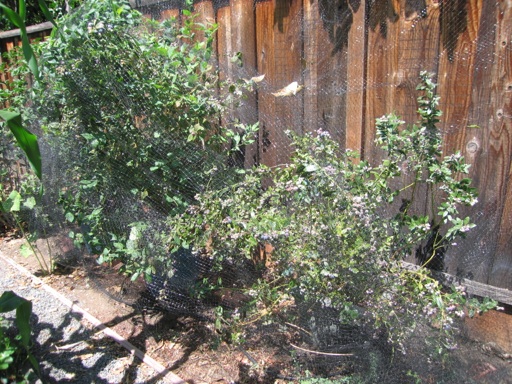
And here is what the same plants looked like in bloom on March 2.
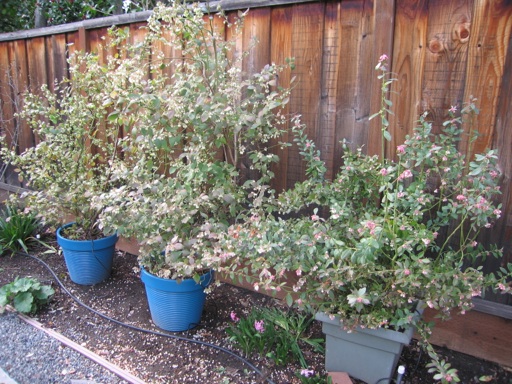
I harvested so many blueberries this week that I had enough to make a blueberry pie and still had some left over.
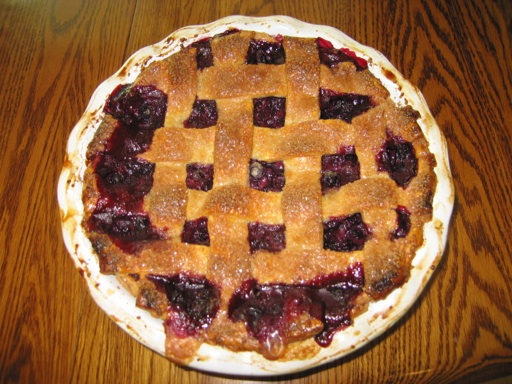
June 06 2014 | Blueberries and Cherries and Strawberries | Comments Off on Berries and Cherries
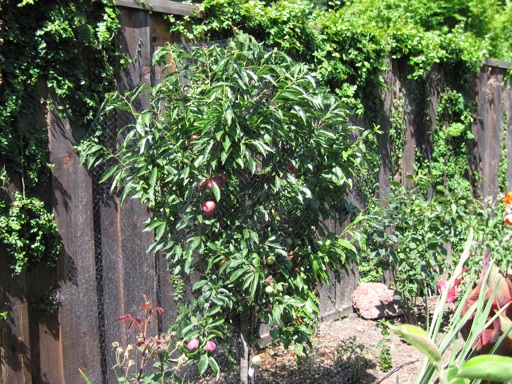
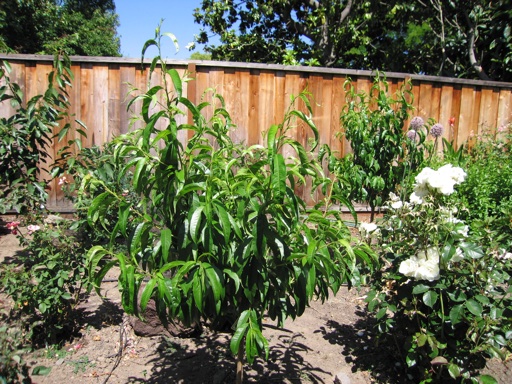
I planted several new fruit trees earlier this year in our yard, including an almond, another peach, a nectarine, a plum, and 2 more cherries. I sometimes hear people say that fruit trees take too many years to produce fruit. For them, I have three words: plums, peaches, and nectarines. All three typically bear fruit by their second year in the ground.
I planted a 4 variety multi-grafted plum tree in February. It already has dozens of plums (see first picture above). Most of the plums are hidden behind the leaves in this picture. The 4 varieties are beauty, nubiana, laroda, and elephant heart. They ripen in June, July, August, and September, respectively, for a 4 four month long plum season. I have already eaten several of the beauty plums, and they are good, with just a little tartness in the skin. Plums produce fruit at a young age. Although my tree wasn’t a new bare root tree when I bought it. It looked like it had been in a pot at least a year.
The other new fruit trees I planted as bare root trees. They don’t have any fruit this year, but they are growing vigorously. The second picture shows the new nectarine (snow queen) in the foreground and the new peach (snow beauty) in the back right. The peach and nectarine trees will likely have their first crop of fruit next summer. Peaches and nectarines produce fruit on branches that grew during the previous year. They also produce fruit at an early age like plums.
I found that one of the keys to growing fruit trees successfully is giving them a regular supply of water and not letting their root systems dry out at any time. In our dry climate, that means regular watering. I have micro-spray devices on all of our fruit trees that are controlled by an automatic watering system. They get watered for about 5 minutes every other day through the spring and summer months. I have found that this schedule keeps the roots moist without over-watering during normal conditions here. During hot weather (90 degrees plus), I water them everyday and/or for a longer time.
Some people are lucky enough to live in climates that get rain on and off throughout the spring and summer months. Last month, I visited family in Kentucky. The small fruit orchard in their backyard includes two peach trees. One of the things I noticed was that the leaves of their peach trees were a pale green color, and they were not actively growing new leaves. The leaves were not a healthy looking deep green like the leaves of our peach trees in California.
My first thought was that they looked like they were not getting enough water. The ground around the trees looked dried out. That seemed strange, because I was told that it had rained a lot in early May before we arrived. Apparently, the sun dries out the ground quickly there too in the late spring.
I have noticed that when fruit trees like peaches don’t get enough water for several days or weeks, the leaves tend to turn pale, and they stop growing. I think that it begins to happen as soon as the roots dry out, which probably happens a lot sooner in young trees that have small roots systems. The lesson I have taken from my experiences is that it is important to prevent the root systems of young fruit trees from drying out, so that they continue to grow through the spring and summer. That’s particularly important for newly planted trees.
Even in Kentucky were it rains frequently through the spring and summer, it’s possible that peaches and other fruit trees can dry out after a week or more without a significant downpour. I was told that nobody bothers to water their outdoor plants in Kentucky, because they feel that there is no need to. But perhaps they should consider supplemental watering during dry spells.
June 21 2009 | Cherries and Peaches/Nectarines and Plums | Comments Off on New Fruit Trees













